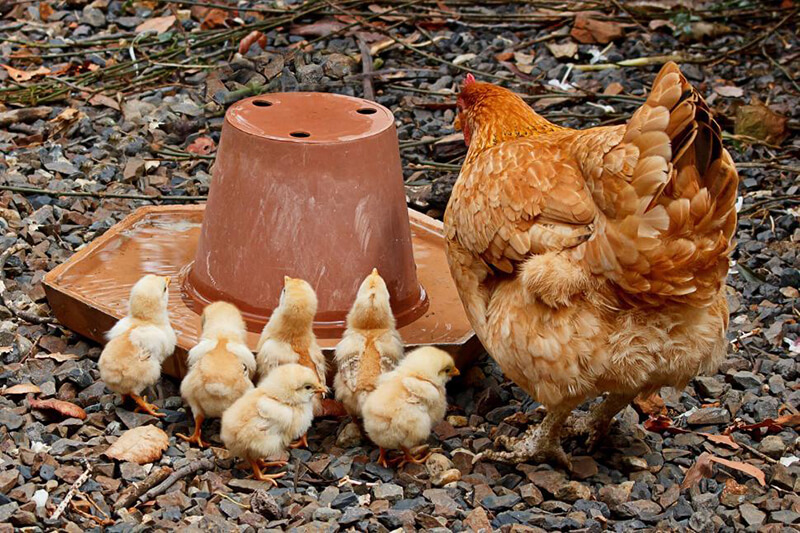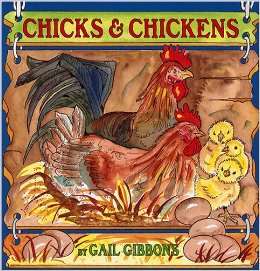From Chicken Little to Chicken Big (Grades K-2)
Students identify different breeds of chickens, examine physical characteristics, and determine the stages of a chicken's life cycle.

Background
Lesson Activities
Recommended Companion Resources
Credits
Author
Darlene Petranick and Michele Reedy | North Carolina Farm Bureau Ag in the Classroom
Standards
Indiana Content Area Standards
-
English Language Arts.Kindergarten.RN.1
Actively engage in group reading activities with purpose and understanding.
- Key Ideas and Textual Support.K.RN.2.1: With support, ask and answer questions about important elements of a text (e.g., events, topics, concepts). Further guidance for support will be provided in the Literacy Framework.
- Key Ideas and Textual Support.K.RN.2.3: With support, describe the connection between two individuals, events, ideas, or pieces of information in a text. Further guidance for support will be provided in the Literacy Framework.
-
English Language Arts.Kindergarten.RV.1
Use words, phrases, and strategies acquired through conversations, reading and being read to, and responding to literature and nonfiction texts to build and apply vocabulary.
- Vocabulary in Literature and Nonfiction Texts.K.RV.3.2: With support, ask and answer questions about unknown words in a nonfiction text.
-
English Language Arts.Kindergarten.W.1
Write for specific purposes and audiences.
- Writing Genres.K.W.3.2: Use words and pictures to develop a main idea and provide some information about a topic.
-
English Language Arts.Kindergarten.SL.1
Listen actively and communicate effectively with a variety of audiences and for different purposes.
- Comprehension.K.SL.3.1: Ask and answer questions about key details in a text read aloud or information presented orally or through other media.
- Discussion and Collaboration.K.SL.2.1: Participate in collaborative conversations about grade-appropriate topics and texts with peers and adults in small and larger groups.
- Discussion and Collaboration.K.SL.2.3: Listen to others, take turns speaking, and add ones own ideas to small group discussions or tasks.
- Presentation of Knowledge and Ideas.K.SL.4.3: Give, restate, and follow simple two-step directions.
-
English Language Arts.Grade 1.RN.1
With support, read and comprehend nonfiction that is grade-level appropriate.
- Key Ideas and Textual Support.1.RN.2.1: Ask and answer questions about key details to clarify and confirm understanding of a text.
-
English Language Arts.Grade 1.RV.1
Use words, phrases, and strategies acquired through conversations, reading, and being read to, and responding to literature and nonfiction texts to build and apply vocabulary.
- Vocabulary Building.1.RV.2.1: Demonstrate understanding that context clues (eg., words and sentence clues) and text features (eg., glossaries, illustrations) may be used to help understand unknown words.
- Vocabulary in Literature and Nonfiction Texts.1.RV.3.2: Ask and answer questions to help determine or clarify the meaning of words and phrases in a nonfiction text.
-
Physical Education: Standard 3
The physically literate individual demonstrates the knowledge and skills to achieve and maintain a health-enhancing level of physical activity and fitness.
- K.3.6.B Physical Education: Identifies healthy and unhealthy foods.
-
English Language Arts.Grade 1.W.1
Write routinely over brief time frame and for a variety of purposes and audiences.
- Conventions of Standard English.1.W.6.1: Demonstrate command of English grammar and usage, focusing on: 1.W.6.1a Nouns/Pronouns Writing sentences that include common and proper nouns and personal pronouns. 1.W.6.1b Verbs Writing sentences using verbs to convey a sense of past, present, and future. 1.W.6.1e Usage Writing complete simple declarative, interrogative, imperative, and exclamatory sentences in response to prompts.
-
English Language Arts.Grade 1.SL.1
Listen actively and adjust the use of spoken language (e.g., vocabulary) to communicate effectively with a variety of audiences and for different purposes.
- Comprehension.1.SL.3.1: Ask and answer questions about what a speaker says to clarify something that is not understood.
- Comprehension.1.SL.3.2: Ask and answer questions about key details in a text read aloud or information presented orally or through other media.
- Discussion and Collaboration.1.SL.2.1: Participate in collaborative conversations about grade-appropriate topics and texts with peers and adults in small and larger groups.
- Discussion and Collaboration.1.SL.2.3: Listen to others, take turns speaking about the topic, and add ones own ideas in small group discussions or tasks.
- Presentation of Knowledge and Ideas.1.SL.4.2: Add drawings or other visual displays, such as pictures and objects, when sharing information to clarify ideas, thoughts, and feelings.
- Presentation of Knowledge and Ideas.1.SL.4.3: Give and follow three- and four-step directions.
-
English Language Arts. Grade 2.RN.1
Read and comprehend a variety of nonfiction within a range of complexity appropriate for grades 2-3. By the end of grade 2, students interact with texts proficiently and independently at the low end of the range and with scaffolding as needed at the high end.
- Key Ideas and Textual Support.2.RN.2.1: Ask and answer questions about the main idea and supporting facts and details in a text to confirm understanding.
- Structural Elements and Organization.2.RN.3.1: Use various text features (e.g., table of contents, index, headings, captions) to locate key facts or information and explain how they contribute to and clarify a text.
-
English Language Arts.Grade 2.RV.1
Use words, phrases, and strategies acquired through conversations, reading and being read to, and responding to literature and nonfiction texts to build and apply vocabulary.
- Vocabulary Building.2.RV.2.1: Use context clues (e.g., words and sentence clues) and text features (e.g., table of contents, headings) to determine the meanings of unknown words.
-
English Language Arts.Grade 2.W.1
Write routinely over brief time frames and for a variety of tasks, purposes, and audiences; apply reading standards to write in response to literature and nonfiction texts.
- Conventions of Standard English.2.W.6.1: Demonstrate command of English grammar and usage, focusing on: 2.W.6.1a Nouns/Pronouns Writing sentences that include common, proper, possessive, and collective nouns, irregular plural nouns, and personal and possessive pronouns. 2.W.6.1b Verbs a. Writing sentences that use the past tense of frequently occurring irregular verbs. b. Understanding the functions of different types of verbs (e.g., action, linking) in sentences. 2.W.6.1c Adjectives/ Adverbs Writing sentences that use adjectives and adverbs. 2.W.6.1e Usage Writing correctly complete simple and compound declarative, interrogative, imperative, and exclamatory sentences.
-
English Language Arts.Grade 2.SL.1
Listen actively and adjust the use of spoken language (e.g., conventions, vocabulary) to communicate effectively with a variety of audiences and for different purposes.
- Discussion and Collaboration.2.SL.2.3: Listen to others, take ones turn in respectful ways, and speak one at a time about the topics and text under discussion.
- Discussion and Collaboration.2.SL.2.5: Build on others talk in conversations by linking comments to the remarks of others.
- Presentation of Knowledge and Ideas.2.SL.4.3: Give and follow multi-step directions.

.jpeg)